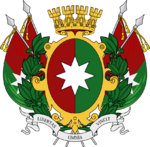History of Aucuria
This article is incomplete because it is pending further input from participants, or it is a work-in-progress by one author. Please comment on this article's talk page to share your input, comments and questions. Note: To contribute to this article, you may need to seek help from the author(s) of this page. |
| This article is part of a series on the |
| History of Aucuria |
|---|
 |
The history of Aucuria extends across more than 10,000 years. One of the world's cradles of civilization, the Pativilkas civilization - the first civilization in Asteria Inferior - emerged in what is now Aucuria in 3,700 BCE. Potatoes, cassava, quinoa, coca, common beans, and the chili pepper species Capsicum baccatum and Capsicum pubescens were all domesticated in ancient Aucuria. After the Pativilkas civilization came a string of major indigenous cultures, including the Kiljakoljas, Tirakvas, Piura, and Kulkinčas.
The League of Five Cities, or Cutinsua, was formed in 1324 in response to the rise of the Kingdom of Oruras. Cutinsuan armies subsequently conquered Oruras in 1336, and came to control much of northern Aucuria through a mixture of diplomacy, assimilation, intimidation, and conquest by the start of the 1500s. By the time that Euclea discovered the Asterias, Cutinsua was the largest, and one of the most advanced and most powerful, states in Asteria Inferior.
Cutinsua was conquered by the Ruttish in 1530. The Ruttish subsequently established a colony in the region; this colony was officially dubbed Aucuria in 1561. Aucuria was declared a co-equal part of a pluricontinental monarchy, the United Kingdom of Ruttland and Aucuria, in 1693; however, the Ten Years' War saw Aucuria transferred to Rudolphine control in 1721. Unpopular Rudolphine policies led to the outbreak of the Aucurian Revolution in 1786. Werania recognized Aucurian independence in 1793.
Following independence, Aucuria endured several swings between republic and dictatorship, defeat in the War of the Arucian, the Aucurian Civil War, and the occupation of the country by the Entente during the Great War. The military regime established by the 1949 Aucurian coup d'etat was overthrown in 1980 with the Velvet Revolution; Aucuria has had a democratic government since.
Pre-Cutinsuan Aucuria
Prehistory
Human remains and stone tools in the Čiklajus valley dated to 12,500 BCE, located in the state of Bendrieji Laukai, provide some of the earliest known evidence of human habitation in Asteria Inferior. Archaeological finds at sites such as Amotapas, Kotošas, Kupeniskvė, Mojekvas, and Senakelios attest to the presence of a series of lithic and preceramic Paleo-Asterian cultures in the area between the 12,000s BCE and the 3,000s BCE.
Potatoes and cassava, which would remain core staple crops in the region for millennia, were domesticated in Aucuria some time between 8,000 BCE and 5,000 BCE. Llamas, alpacas, and guinea pigs were domesticated in Aucuria in the 6,000s BCE; the domestication of quinoa, ullucu, mashua, and oca took place in Aucuria in the 2,000s BCE. The cultivation of corn, cotton, and calabashes spread to the region from Asteria Superior between 5,000 and 4,000 BCE. These indigenous populations spun and knit wool and cotton, and practiced basketry, but were aceramic and thus did not make pottery.
[arrival of cotton appears to be associated with a shift generally towards small sedentary villages, enabled by primitive irrigation canals and by the use of cotton for fishing nets and bags]

Pativilkas civilization
[3,700-1,500 BCE; the first civilization in the asterias and the last phase of the preceramic period in aucuria]
Kiljakoljas culture
[1,300-300 BCE]
Sythe-Juoda culture
[500 BCE-1000]
Tirakvas and Piura cultures
[100 BCE-800]
Marai in Aucuria
[100-800]
Kulkinčas culture
[800-1200]
Kingdom of Oruras
[1252-1300s]
Cutinsua
Formation and early consolidation
[1324-1336 is initial formation and conquest of oruras]
[until 1417 - mankojupankis is the dynamic first ruler, tupakvalpas is unremarkable]
[atokjupankis v javarvakakas, the consolidation of andavailan hegemony]
[minor expansion under sinciankas, tupakukumarkis]
Reform and later expansion
[1417 to 1525 - the wars of ljokeamaras; his sidelining]
[the conquests and reforms of capatipomas sinčijačekas]
[maitakapakis, ljaktakusaris, and the early years of javarjupankis]
Colonial Aucuria
Ruttish conquest of Cutinsua
[conquest, summarized]
Ruttish Aucuria
[initially relies more heavily on local collaborators, kasikai and kurakai]
[beginning to do away with this in the 1590s leads to the 1608-1612 great cutinsuan revolt]
[as institutions created and strengthened, increasingly uniquely aucurian identity]
[ruttland depends on aucurian crops and the profits thereof, so to guarantee its continued connection to ruttland, it decides to create the UKRA]
United Kingdom of Ruttland and Aucuria
[further strengthening of local institutions due to the elevation of aucuria to equal status w/ ruttland]
[ten years war in aucuria]
Rudolphine Aucuria
[reduced back to colony, unpopular tariff policy, suppression of ruttish language, and promotion of weranian settlement stokes anger]
War of Independence
[course of the war]
Aucurian Republic
Early republic
[first republic - agrarian devolutionists vs. commercial centralists, w/ conservative monarchists mostly sidelined]
[second republic - dabrauskas]
[third republic until 1883 - (semi-)liberal modernists vs. moralistic conservatives, w/ smaller civilist and radical factions]
Arucian War through the Great War
[war of the arucian]
[aucurian civil war]
[fourth republic - (semi-)liberal modernists vs. moralistic conservatives vs. progressives and socialists]
[great war]
Postwar period
[fifth republic - liberal modernists vs. social democrats vs. very unhappy conservatives vs. socialists and ethnic groups]
Military dictatorship
[sixth republic - military dictatorship, years of lead, sugar crash and sugar high]
[velvet revolution]
Redemocratization into the present
[seventh republic]





